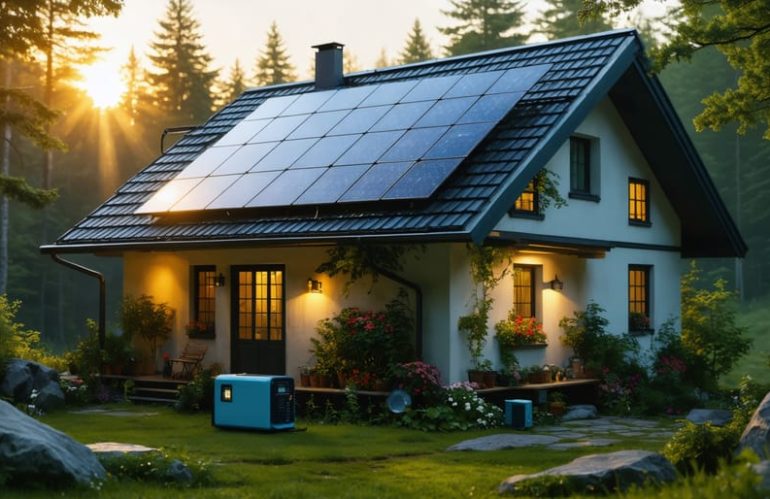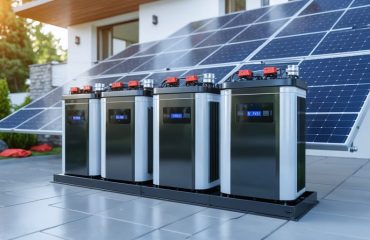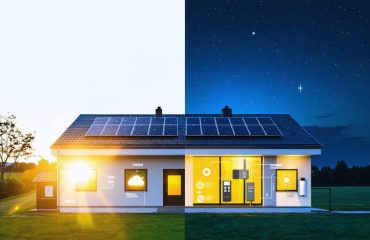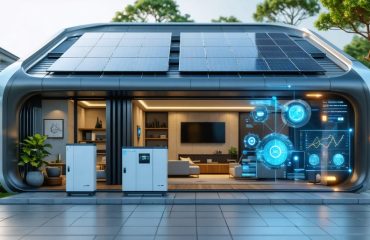Achieve true energy independence by combining a home solar system with a reliable backup generator. This powerful duo delivers uninterrupted power through all seasons and weather conditions, while significantly reducing or eliminating monthly utility bills. Modern off-grid systems seamlessly integrate solar panels, battery storage, and generators to create a robust energy solution that matches grid reliability without the ongoing costs. Whether you’re looking to power a remote cabin or secure your suburban home against outages, this combination offers the perfect balance of renewable energy and conventional backup power. With proper sizing and smart automation, your system can automatically switch between solar, battery, and generator power to maintain consistent energy flow while maximizing efficiency and minimizing fuel consumption.

Components of a Reliable Off-Grid Solar System
Solar Panels and Array Sizing
Selecting the right solar panels and determining the correct system size are crucial steps in creating effective solar backup power systems. Modern solar panels come in two main types: monocrystalline and polycrystalline. Monocrystalline panels offer higher efficiency and take up less space, while polycrystalline panels are more budget-friendly but require larger installation areas.
To calculate your system size, start by reviewing your monthly energy consumption from utility bills. A good rule of thumb is to add 20% to your average daily usage to account for system losses and future needs. Consider factors like your geographic location, roof orientation, and available installation space. Most residential off-grid systems range from 5kW to 10kW, depending on household needs.
For optimal performance, your solar array should be able to generate enough power during peak sunlight hours to both meet your daily needs and charge your batteries. Working with a qualified installer can help ensure your system is properly sized to maintain energy independence while maximizing your investment.
Battery Bank Requirements
A reliable battery bank is the heart of any off-grid solar system, storing energy for use when the sun isn’t shining. Modern battery storage solutions typically use lithium-ion technology, offering better performance and longer life than traditional lead-acid batteries. For most households, a battery bank capacity of 20-30 kWh provides sufficient storage for daily use, though your specific needs may vary based on energy consumption patterns.
When sizing your battery bank, consider your daily power usage and aim to store enough energy for 2-3 days of autonomy. This buffer ensures you’ll have power during cloudy periods before needing to rely on your backup generator. Factor in a depth of discharge (DoD) of 80% for lithium batteries to maximize their lifespan.
Temperature-controlled installation locations are crucial for optimal battery performance, as extreme temperatures can affect efficiency and longevity. Most modern batteries include built-in battery management systems (BMS) that protect against overcharging and maintain balanced cell voltage, making them safer and more reliable for home use.
Inverters and Charge Controllers
Inverters and charge controllers are the brains of your off-grid solar system, working together to manage power flow efficiently. The inverter converts DC power from your solar panels and batteries into AC power that your home appliances can use. Look for pure sine wave inverters, which provide the cleanest power for sensitive electronics and appliances.
Charge controllers protect your batteries by preventing overcharging and ensuring optimal charging cycles. MPPT (Maximum Power Point Tracking) controllers are worth the investment, as they can increase solar charging efficiency by up to 30% compared to simpler PWM controllers. When selecting these components, choose models that can handle your power needs with some room for future expansion. Make sure they’re compatible with your backup generator to ensure seamless power switching during extended periods without sun.
Integrating Your Backup Generator
Choosing the Right Generator Size
Selecting the right generator size for your off-grid solar system is crucial for ensuring reliable backup power without unnecessary expense. To determine the appropriate capacity, start by listing your essential appliances and their power requirements. Most homes can manage well with a generator between 5,000 to 7,500 watts, but your specific needs may vary.
Consider these key factors when sizing your generator:
– Peak power demands during outages
– Duration of typical backup needs
– Seasonal variations in energy consumption
– Battery bank charging requirements
– Future expansion plans
A good rule of thumb is to choose a generator that can handle about 20% more than your calculated power needs. This provides a safety margin for unexpected loads and ensures efficient battery charging. For example, if your essential loads total 4,000 watts, consider a 5,000-watt generator.
Remember that bigger isn’t always better. An oversized generator will run less efficiently and consume more fuel, while an undersized unit will struggle to meet your needs and may have a shorter lifespan due to constant strain. Focus on matching the generator to your actual requirements rather than maximum theoretical loads.
For most off-grid homes, a quality generator in the range of 6,500 watts provides an optimal balance between power capacity and fuel efficiency. This size typically allows for comfortable living while maintaining reasonable fuel consumption.
Automatic vs. Manual Transfer Switches
When connecting a backup generator to your off-grid solar system, you’ll need to choose between automatic and manual transfer switches. Automatic transfer switches detect power interruptions instantly and seamlessly switch to generator power without any intervention. While more expensive initially, they provide peace of mind and are ideal for homes where you might be away during power issues or prefer a hands-off approach.
Manual transfer switches, on the other hand, require you to physically flip the switch to transition between power sources. They’re more affordable and simpler to maintain, making them a popular choice for budget-conscious homeowners. While they require more attention during power transitions, many find the direct control appealing and appreciate the straightforward operation.
Both options are safe and reliable when properly installed. Your choice might depend on factors like budget, comfort with handling power systems, and how quickly you need backup power to kick in. Consider your lifestyle and how often you expect to use the backup generator when making your decision.

Smart Integration Systems
Modern off-grid solar systems feature sophisticated integration technology that makes managing your backup generator easier than ever. Automatic transfer switches (ATS) seamlessly transition between solar power and generator backup when needed, eliminating the hassle of manual switching. These smart controllers monitor your battery levels and automatically start the generator when charge levels drop below a preset threshold.
Many systems now come with user-friendly mobile apps that let you monitor and control your entire setup from your smartphone. You can track power production, battery status, and generator runtime remotely. Some advanced systems even use weather forecasting data to optimize when to run your generator for charging, saving fuel and reducing unnecessary runtime.
Smart load management features help prioritize essential appliances during generator operation, ensuring efficient power distribution. The latest integration systems also include protective features that prevent generator damage from overloading and maintain optimal charging patterns for your batteries, extending the life of both components.
These intelligent solutions make operating an off-grid system with backup power as convenient as being connected to the grid, while maintaining complete energy independence.
Real-World Performance and Maintenance
Daily Operation and Monitoring
Managing your off-grid solar system with backup generator is straightforward once you understand the daily routine. The system automatically prioritizes solar power during daylight hours, drawing energy from your panels to power your home and charge the batteries. The charge controller monitors battery levels and manages the charging process to protect battery life.
During normal operation, your battery bank provides power during nighttime or cloudy periods. The system’s inverter converts the stored DC power to AC electricity for your home appliances. Monitor your battery levels through the system’s display panel – most modern systems offer smartphone apps for convenient tracking.
The backup generator comes into play when battery levels drop below a preset threshold, typically around 50%. The automatic transfer switch activates the generator, which powers your home and recharges the batteries simultaneously. Once batteries reach about 80-90% charge, the generator shuts off automatically, returning to solar as the primary power source.
To optimize system performance, check weather forecasts and adjust your energy usage accordingly. During extended periods of poor weather, consider running the generator during off-peak hours to top up batteries. Regular monitoring helps you understand your energy patterns and make adjustments for maximum efficiency. Most homeowners find they only need to run their generators occasionally, primarily during winter months or extended cloudy periods.

Maintenance Schedule
Regular maintenance is crucial for keeping your off-grid system running efficiently. A well-maintained system can last longer and perform better, saving you money in the long run. For optimal performance, incorporate these maintenance tasks into your routine solar system maintenance schedule.
For solar components:
– Clean solar panels every 3-4 months or after storms
– Check and tighten electrical connections quarterly
– Inspect mounting hardware twice yearly
– Monitor battery fluid levels monthly (for lead-acid batteries)
– Test charge controller settings every six months
– Verify inverter operation monthly
For backup generator:
– Change oil every 50-200 operating hours
– Replace air filters every 200 hours
– Check fuel lines and connections monthly
– Test automatic transfer switch quarterly
– Run the generator monthly for 30 minutes
– Schedule professional inspection annually
Keep a maintenance log to track all services and inspections. Set calendar reminders for routine tasks, and always follow manufacturer guidelines for specific maintenance requirements. Remember that preventive maintenance is far less expensive than emergency repairs. During seasonal changes, pay extra attention to weather-related impacts on your system components. Consider scheduling professional check-ups annually to ensure everything is working at peak efficiency.
Cost Considerations and ROI
Installing an off-grid solar system with a backup generator requires careful financial planning, but the long-term benefits often justify the initial investment. The typical upfront cost ranges from $25,000 to $45,000 for a complete system capable of powering an average home, including solar panels, batteries, inverters, and a backup generator.
The largest portion of your investment will go toward solar panels and battery storage, typically accounting for about 60% of the total cost. A quality backup generator adds $3,000 to $7,000 to the project, depending on size and features. Installation costs usually make up 20-25% of the total investment.
While these numbers might seem substantial, consider the return on investment (ROI). Most homeowners recover their costs within 7-12 years through eliminated utility bills and reduced maintenance expenses. Federal tax incentives can offset up to 30% of your initial investment, and many states offer additional rebates or incentives that further improve ROI.
Annual maintenance costs are relatively modest, typically ranging from $200 to $400 for routine system checks and battery maintenance. The backup generator requires additional maintenance, usually costing $100-200 per year, including oil changes and general upkeep.
To maximize your ROI, consider these factors:
– Size your system appropriately for your needs
– Invest in high-quality components that offer better longevity
– Take advantage of available tax incentives and rebates
– Implement energy-efficient practices to reduce overall power requirements
– Schedule regular maintenance to extend system life
Remember that while the upfront costs are significant, an off-grid system provides energy independence, protection from rising utility rates, and increased property value. Many homeowners report a 3-4% increase in their home’s market value after installing a complete off-grid system.
Taking control of your energy future with an off-grid solar system backed by a generator is a smart and achievable goal. By combining solar panels, batteries, and a backup generator, you create a reliable and sustainable power solution that provides independence from the grid while ensuring your home never goes dark.
Remember that successful implementation starts with proper sizing of your system components, including solar panels that match your daily energy needs and batteries that provide adequate storage. Your backup generator serves as an essential safety net, ready to step in during extended periods of limited sunlight or unexpected power demands.
While the initial investment may seem substantial, the long-term benefits are clear: reduced or eliminated electricity bills, protection from power outages, and a smaller carbon footprint. Regular maintenance of your system components will ensure optimal performance and longevity, making your investment even more worthwhile.
Whether you’re motivated by environmental concerns, seeking energy independence, or looking to reduce utility costs, an off-grid solar system with backup generator provides a reliable solution. Consider consulting with qualified solar installers who can help design a system tailored to your specific needs and location. By taking action today, you’re investing in a sustainable and secure energy future for your home.









